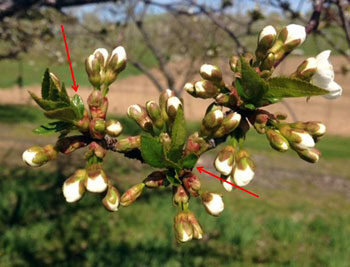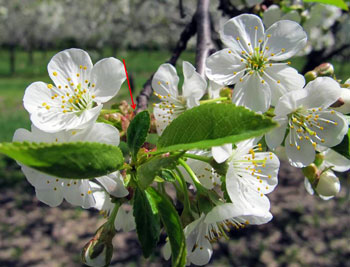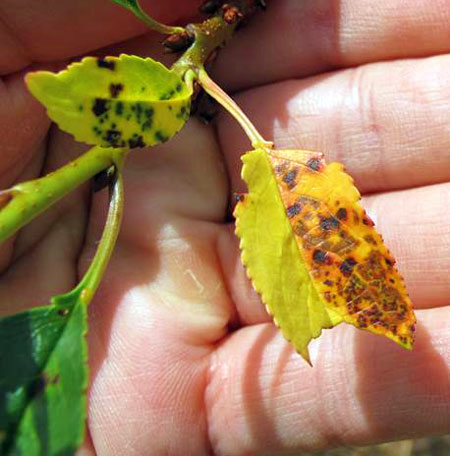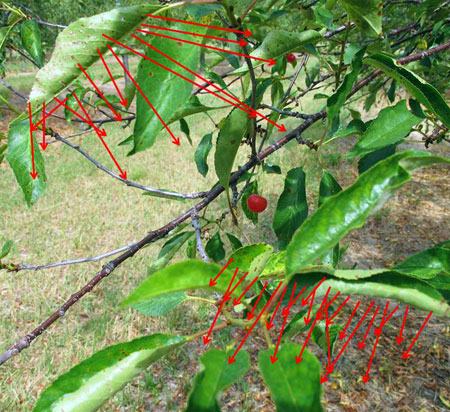Cherry leaf spot: get an early start on protection before the fungus gets started on infection
It’s critical to protect tart cherry trees early in the season from cherry leaf spot infection. Protection at the bract leaf stage with chlorothalonil will get your control season off to an excellent start.
For effective cherry leaf spot management, Michigan State University Extension used to suggest that the first fungicide application must be made around tart cherry petal fall to adequately protect the first fully-expanded leaves from fungal infection. The cherry leaf spot fungus infects leaves through stomata, and these parts of the leaf structure are not open and functional until the first leaves are mature. However, as we found in 2012 when we sustained early and epidemic levels of cherry leaf spot, the past strategy did not take the first bract leaves into account. Bract leaves open prior to bloom, and open bract leaves can be infected early, prior to petal fall.


Photo 1. Bract leaves (shown by red arrows) developing prior to tart cherry bloom and during bloom.
In 2012, we observed many orchards in Northwest Michigan with severe leaf spot infection by mid- to late-June. This situation was somewhat surprising because environmental conditions were not exceptionally conducive for leaf spot infection. However, upon further examinations of infected trees, we found significant infection of these early forming bract leaves (Photo 2), and as we have been saying with early apple scab infection, these early infections can drastically jump-start an epidemic.

Photo 2. Infected early forming bract leaves.
There are two main reasons that early infection can result in a fungal epidemic:
- Once fungal infection occurs in the tree, the fungus will produce tremendous spore numbers from lesions established on the leaves, and in most cases, there are usually more spores developing from lesions than ascospores that are coming up from leaves overwintering on the ground.
- Spores from lesions on the leaves are much more likely to find new leaf targets within the tree than spores coming up from the ground. The distance from one leaf to another leaf on a tree is minimal, and the potential for spores to infect by moving from one leaf to an adjacent leaf is “easier” than for spores shot from ground level to hit the leaf target up in the tree canopy (Photo 3). This early infection from leaf to leaf can result in a major infection event.

Photo 3. Adjacent leafs are at risk of being infected with spores.
The goal of our cherry leaf spot sprays is to prevent or delay initial infection events. As with all other diseases, cherry leaf spot infection will rise to epidemic proportions under conducive weather conditions, and with less infection early, there will be less inoculum in the tree that growers will have to control during times with more optimal conditions for cherry leaf spot development. Thus, the purpose of early season sprays is to prevent or significantly delay initial infection events. Early season control will help with disease control prior to harvest (severe, early season infection can affect fruit ripening) and help trees hold leaves into September. At the bract leaf stage, trees must be covered to prevent infection prior to rain events that could trigger a cherry leaf spot infection, according to Enviro-weather.
Prior to shuck split, the recommended fungicide for cherry leaf spot management is chlorothalonil (Bravo and generics). This fungicide is a multi-site protectant and is excellent for leaf spot control and is not at risk for fungicide resistance development. At least two applications of chlorothalonil should be made before shuck split with the goal to minimize the potential of infection at this early timing.
Dr. Sundin's work is funded in part by MSU's AgBioResearch.



 Print
Print Email
Email


